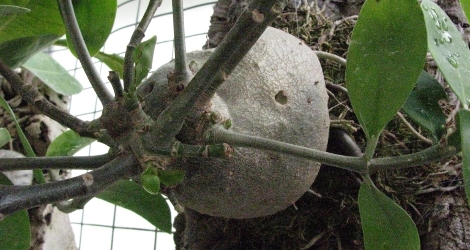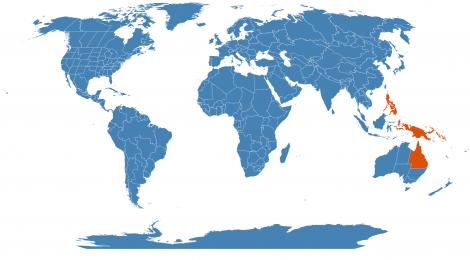Accession Data:
Hydnophytum moseleyanum Becc.
- Common Name: Hydnophytum, Ant Plant
- Family: Rubiaceae Juss.
- Description: Plants form a symbiotic relationship with ants and fungi. Ant plants provide habitats for ant colonies high up into the forest canopy, protecting them from the elements and also predators because of the spines. Hollow, smooth-walled tunnels form within the caudex with external entrance holes, providing an above-ground home for ant colonies. Ants likewise provide defense for the plant and prevent tissue damage. Ant colonies also provide nutrients to the plants by leaving wastes within the tunnels inside the caudex. Special glands lining the tunnels then absorb nutriment for the plant. This symbiosis allows the plants to effectively gather nutrients (via the ants) from a much larger area than the roots ever could cover.2
- Culture: See Plummer, N., Cultivation of the epiphytic ant-plants Hydnophytum and Myrmecodia, Cactus and Succulent Journal 72:142-147 (2000)
- USDA Zone: 10a-11
Accession Data:
- Accession # 198500652
- Source: Jacks
- Provenance: name changed from Hydnophytum formicarum to H. moseleyanum - visit/consultation with Frank Omilian.
- Accession Date: 12-31-1985
- Bench: 4104 - EPI: East Rack B
- Currently: active - healthy
- Qty: 1 confirmed on 07-01-2025
Classification:
- Division: Magnoliophyta
- Class: Magnoliopsida
- SubClass: euasterid I
- Order: Gentianales
- SubOrder:
- Family: Rubiaceae
- SubFamily: Rubioideae
- Tribe: Psychotrieae
- SubTribe: Hydnophytinae
Flowering Data:
This accession has been observed in bloom on:| Year | Jan | Feb | Mar | Apr | May | Jun | Jul | Aug | Sep | Oct | Nov | Dec | ||||||||||||||||||||||||||||||||||||||||
|---|---|---|---|---|---|---|---|---|---|---|---|---|---|---|---|---|---|---|---|---|---|---|---|---|---|---|---|---|---|---|---|---|---|---|---|---|---|---|---|---|---|---|---|---|---|---|---|---|---|---|---|---|
| 2025 | ||||||||||||||||||||||||||||||||||||||||||||||||||||
| 2024 | ||||||||||||||||||||||||||||||||||||||||||||||||||||
| 2023 | ||||||||||||||||||||||||||||||||||||||||||||||||||||
| 2022 | ||||||||||||||||||||||||||||||||||||||||||||||||||||
| 2021 | ||||||||||||||||||||||||||||||||||||||||||||||||||||
| 2020 | ||||||||||||||||||||||||||||||||||||||||||||||||||||
| 2019 | ||||||||||||||||||||||||||||||||||||||||||||||||||||
| 2018 | ||||||||||||||||||||||||||||||||||||||||||||||||||||
| 2017 | ||||||||||||||||||||||||||||||||||||||||||||||||||||
| 2016 | ||||||||||||||||||||||||||||||||||||||||||||||||||||
| 2015 | ||||||||||||||||||||||||||||||||||||||||||||||||||||
| 2014 | ||||||||||||||||||||||||||||||||||||||||||||||||||||
| 2013 | ||||||||||||||||||||||||||||||||||||||||||||||||||||
| 2012 | ||||||||||||||||||||||||||||||||||||||||||||||||||||
| 2011 | ||||||||||||||||||||||||||||||||||||||||||||||||||||
| 2010 | ||||||||||||||||||||||||||||||||||||||||||||||||||||
| 2009 | ||||||||||||||||||||||||||||||||||||||||||||||||||||
| 2008 | ||||||||||||||||||||||||||||||||||||||||||||||||||||
References (internal):
- Ant Plants (myrmecophytes)
- EEB 3203 - Developmental Plant Morphology
- AntU - Learning from the Complex Society of Army Ants & Their Guests
- Plants used in EEB 2244 - General Ecology
- Scavenger Hunt - Grades 9-12 (generic)
- ECE 2019 - Scavenger Hunt
- EEB Greenhouse Holdings native to: Maluku / Philippines / Bismarck Archipelago / New Guinea / Solomon Is. / Queensland
References (external):
- Plummer, N., Cultivation of the epiphytic ant-plants Hydnophytum and Myrmecodia, Cactus and Succulent Journal 72:142-147 (2000)
- Wikipedia
- Exotica 4, by AB Graf, 1982
- The Plant List (2013). Version 1.1. Last accessed on Wednesday, July 19, 2017.
- WCSP (2016). World Checklist of Selected Plant Families. Facilitated by the Royal Botanic Gardens, Kew. Last accessed on Wednesday, July 19, 2017.
data regenerated on Tue, 01 Jul 2025 11:12:13 -0400 [bcm v4.0]
Images:

Additional images for this accession:
Click on thumbnails to enlargeCurrent Accessions in the Rubiaceae
Subfamily Cinchonoideae
Tribe Catesbaeeae
Subfamily Cinchonoideae
Tribe Cephalantheae
Subfamily Cinchonoideae
Tribe Guettardeae
Subfamily Cinchonoideae
Tribe Mussaendeae
Subfamily Cinchonoideae
Tribe Naucleeae
Subfamily Ixoroideae
Tribe Coffeeae
Subfamily Ixoroideae
Tribe Gardenieae
- Burchellia bubalina


- Gardenia jasminoides

- Gardenia jasminoides

- Mitriostigma axillare


- Rosenbergiodendron longiflorum

Subfamily Ixoroideae
Tribe Ixoreae
Subfamily Ixoroideae
Tribe Posoquerieae
Subfamily Ixoroideae
Tribe Vanguerieae
Subfamily Rubioideae
Tribe Coussareeae
Subfamily Rubioideae
Tribe Hedyotideae
Subfamily Rubioideae
Tribe Psychotrieae
- Carapichea ipecacuanha


- Palicourea unidentified
- Psychotria kirkii


- Hydnophytinae: Hydnophytum aff. moseleyanum

- Hydnophytinae: Hydnophytum formicarum W/C



- Hydnophytinae: Hydnophytum formicarum


- Hydnophytinae: Hydnophytum formicarum


- Hydnophytinae: Hydnophytum formicarum 'Europa'

- Hydnophytinae: Hydnophytum longistylum W/C


- Hydnophytinae: Hydnophytum moseleyanum W/C


- Hydnophytinae: Hydnophytum moseleyanum



- Hydnophytinae: Hydnophytum orichalcum

- Hydnophytinae: Hydnophytum papuanum

- Hydnophytinae: Hydnophytum puffii



- Hydnophytinae: Hydnophytum ramispinum


- Hydnophytinae: Hydnophytum simplex

- Hydnophytinae: Hydnophytum sp. W/C
- Hydnophytinae: Myrmecodia beccarii


- Hydnophytinae: Myrmecodia platytyrea


- Hydnophytinae: Myrmecodia platytyrea



- Hydnophytinae: Myrmecodia platytyrea ssp. antoinii

- Hydnophytinae: Myrmecodia sp.

- Hydnophytinae: Myrmecodia sp.


- Hydnophytinae: Myrmecodia sp.

- Hydnophytinae: Myrmecodia tuberosa


- Hydnophytinae: Myrmecodia tuberosa 'armata'

- Hydnophytinae: Myrmecodia tuberosa 'dahlii'

- Hydnophytinae: Myrmephytum beccarii

- Hydnophytinae: Myrmephytum cf. selebicum


- Hydnophytinae: Squamellaria guppyana

Subfamily Rubioideae
Tribe Putorieae
- Plocama pendula W/C

Subfamily Rubioideae
Tribe Rubieae
W/C = Wild Collected
 = indicates flowering in past 14 days
= indicates flowering in past 14 days
 = images available for this accession
= images available for this accession
 = map available for this accession
= map available for this accession
 = accession added within past 90 days
= accession added within past 90 days



